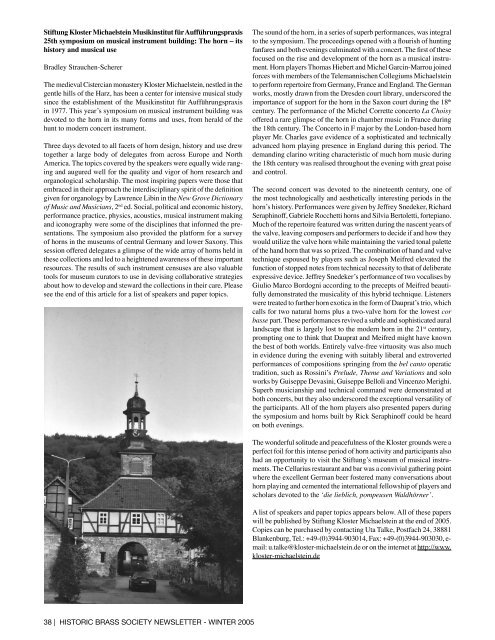18 News - Historic Brass Society
18 News - Historic Brass Society
18 News - Historic Brass Society
You also want an ePaper? Increase the reach of your titles
YUMPU automatically turns print PDFs into web optimized ePapers that Google loves.
Stiftung Kloster Michaelstein Musikinstitut für Aufführungspraxis<br />
25th symposium on musical instrument building: The horn – its<br />
history and musical use<br />
Bradley Strauchen-Scherer<br />
The medieval Cistercian monastery Kloster Michaelstein, nestled in the<br />
gentle hills of the Harz, has been a center for intensive musical study<br />
since the establishment of the Musikinstitut für Aufführungspraxis<br />
<br />
devoted to the horn in its many forms and uses, from herald of the<br />
hunt to modern concert instrument.<br />
Three days devoted to all facets of horn design, history and use drew<br />
together a large body of delegates from across Europe and North<br />
America. The topics covered by the speakers were equally wide ranging<br />
and augured well for the quality and vigor of horn research and<br />
organological scholarship. The most inspiring papers were those that<br />
<br />
given for organology by Lawrence Libin in the <br />
, 2 nd ed. Social, political and economic history,<br />
performance practice, physics, acoustics, musical instrument making<br />
and iconography were some of the disciplines that informed the presentations.<br />
The symposium also provided the platform for a survey<br />
of horns in the museums of central Germany and lower Saxony. This<br />
session offered delegates a glimpse of the wide array of horns held in<br />
these collections and led to a heightened awareness of these important<br />
resources. The results of such instrument censuses are also valuable<br />
tools for museum curators to use in devising collaborative strategies<br />
about how to develop and steward the collections in their care. Please<br />
see the end of this article for a list of speakers and paper topics.<br />
The sound of the horn, in a series of superb performances, was integral<br />
<br />
<br />
focused on the rise and development of the horn as a musical instrument.<br />
Horn players Thomas Hiebert and Michel Garcin-Marrou joined<br />
forces with members of the Telemannischen Collegiums Michaelstein<br />
to perform repertoire from Germany, France and England. The German<br />
works, mostly drawn from the Dresden court library, underscored the<br />
importance of support for the horn in the Saxon court during the <strong>18</strong> th<br />
century. The performance of the Michel Corrette concerto <br />
offered a rare glimpse of the horn in chamber music in France during<br />
the <strong>18</strong>th century. The Concerto in F major by the London-based horn<br />
player Mr. Charles gave evidence of a sophisticated and technically<br />
advanced horn playing presence in England during this period. The<br />
demanding clarino writing characteristic of much horn music during<br />
the <strong>18</strong>th century was realised throughout the evening with great poise<br />
and control.<br />
The second concert was devoted to the nineteenth century, one of<br />
the most technologically and aesthetically interesting periods in the<br />
<br />
Seraphinoff, Gabriele Rocchetti horns and Silvia Bertoletti, fortepiano.<br />
Much of the repertoire featured was written during the nascent years of<br />
the valve, leaving composers and performers to decide if and how they<br />
would utilize the valve horn while maintaining the varied tonal palette<br />
of the hand horn that was so prized. The combination of hand and valve<br />
technique espoused by players such as Joseph Meifred elevated the<br />
function of stopped notes from technical necessity to that of deliberate<br />
<br />
Giulio Marco Bordogni according to the precepts of Meifred beautifully<br />
demonstrated the musicality of this hybrid technique. Listeners<br />
<br />
calls for two natural horns plus a two-valve horn for the lowest <br />
basse part. These performances revived a subtle and sophisticated aural<br />
landscape that is largely lost to the modern horn in the 21 st century,<br />
prompting one to think that Dauprat and Meifred might have known<br />
the best of both worlds. Entirely valve-free virtuosity was also much<br />
in evidence during the evening with suitably liberal and extroverted<br />
performances of compositions springing from the operatic<br />
and solo<br />
works by Guiseppe Devasini, Guiseppe Belloli and Vincenzo Merighi.<br />
Superb musicianship and technical command were demonstrated at<br />
both concerts, but they also underscored the exceptional versatility of<br />
the participants. All of the horn players also presented papers during<br />
the symposium and horns built by Rick Seraphinoff could be heard<br />
on both evenings.<br />
The wonderful solitude and peacefulness of the Kloster grounds were a<br />
perfect foil for this intense period of horn activity and participants also<br />
ments.<br />
The Cellarius restaurant and bar was a convivial gathering point<br />
where the excellent German beer fostered many conversations about<br />
horn playing and cemented the international fellowship of players and<br />
scholars devoted to the .<br />
A list of speakers and paper topics appears below. All of these papers<br />
will be published by Stiftung Kloster Michaelstein at the end of 2005.<br />
Copies can be purchased by contacting Uta Talke, Postfach 24, 38881<br />
Blankenburg, Tel.: +49-(0)3944-903014, Fax: +49-(0)3944-903030, e-<br />
mail: u.talke@kloster-michaelstein.de or on the internet at http://www.<br />
kloster-michaelstein.de<br />
38 | HISTORIC BRASS SOCIETY NEWSLETTER - WINTER 2005
















